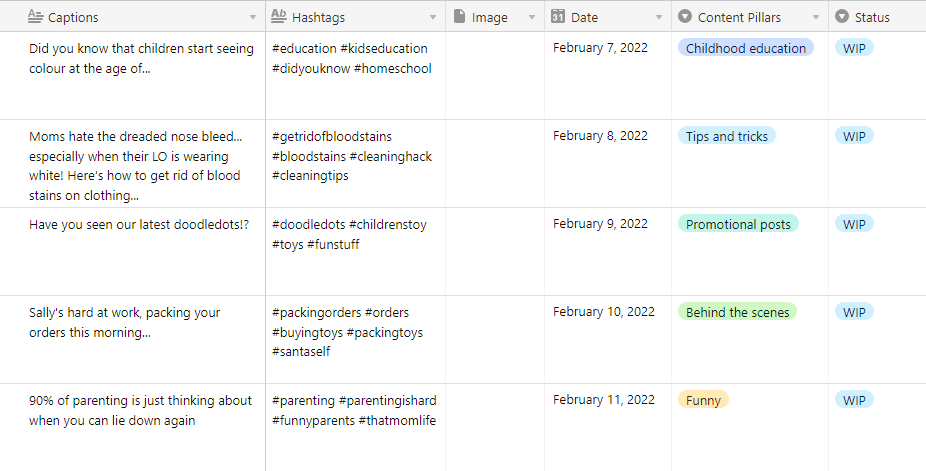
Create a social media strategy and plan for all of 2022… in a day!
Everyone wants to go viral on social media; it’s like living the dream, right? The problem is that very few people know how to create consistent, and engaging content for their social platforms, to generate the kind of returns they want (and often expect).
I show you the simplest way to create a social media strategy and plan, tailor-made to get your business some attention. What’s more, this plan can be created in less than a day!
Why should you listen to me? As a small biz owner myself, I’ve grown my Tik Tok account by over 450,000 followers in less than a year! This led to my Facebook group growing by 1500 and my email list by over 3000, which has translated into real ‘moolah’.
It’s absolutely possible for you too, if you simply plan ahead, use the right tools, and create ‘edutaining’ content that resonates with your audience. Are you ready to get started too?
Step 1: Determine your objectives
First things first, what are you looking to achieve through your social media? And before you say ‘I want to make all the money, Sally!’ let me just stop you right there. You should consider that social media is typically what we call a ‘long game’. Yes, it can be used to generate sales, but in the beginning, you’re much more likely to start generating brand awareness, before sales.
That’s not to say that it shouldn’t be an objective, but it shouldn’t be the main focus as you start posting on social media.
Here are some common objectives for social media:
- Increase brand awareness
- Increase traffic to a website
- Generate leads
- Increase sales
I’ve listed them from top of the funnel all the way to bottom; from just learning about your brand, all the way to making a purchase.
Choose your KPIs
Another point of consideration is how you’re going to measure whether or not you’ve hit those objectives. We call these Key Performance Indicators (KPIs) and you get to choose which ones to focus on.
These are correlated to the objectives you’ve chosen above; see the examples below:
KPIs for increasing brand awareness
- # of followers (how many people subscribed to see your content?)
- Total reach (how many people are seeing your content?)
- Mentions, shares, etc. (how many people are talking about you or sharing your content?)
KPIs for increasing traffic to a website
- Website visitors from social media
- Bounce rate from social media (how many people left your site on the first page they landed on)
KPIs for generating leads
- Lead gen traffic from social media
- Conversions from social media
KPIs for increasing sales
- Sales (from social media specifically)
Once these steps have been completed, it’s time to choose who you plan on targeting with your content.
Step 2: Select your target market
This part is likely going to be easy for you, as it is the market you’ve already determined for your business/products.
However, where things may get complicated is when you have several types of customers, B2B AND B2C, or Moms AND Dads. It’s very hard to create and grow a social media account that is not ‘niched down’ to a particular type of persona/market. In this case, we recommend you choose 1 and stick to that market for a single social media account moving forward.
E.g. You have an Instagram account for your B2B followers and another Instagram account for your B2C customers.
Step 3: Choose your social platforms
Before choosing your platforms you need to ask yourself a few questions.
Where is my audience spending their time?
Start by looking at the demographic stats of each social platform and select the ones where your target market spends most of its time. So for example, if your audience is millennial moms, you may want to choose Tik Tok, Instagram, or Pinterest.
But there are other considerations to take into account.
What content do I need and can I create it myself?
Additional considerations would be the kinds of content that are posted on social platforms and if they’re the best at showcasing your products and services. Finally, you’ll have to determine whether or not you're good at creating that type of content.
Let's say that you have a product that looks great on video, needs a demo on how it works, and you're also really good at creating video content. In this case, you may decide that Tik Tok is the ideal platform to reach your audience and show off your products.
If, however, you are much better at taking aesthetically beautiful pictures, you may decide that Instagram is the better tool for you.
Finally, you need to ask yourself one more question…
How much time do I have to create content?
You never want to bite off more than you can chew. Consider the size of your team, how long it takes to create the type of content you’ll be featuring, and how often the platform suggests you post.
Step 4: Create pillars of content
Now we’re diving deep into the type of content you’ll be producing. Ask yourself what topics or categories you’ll be posting about on your social media.
For example, if you sell children’s toys, content pillars for your social media might be:
- Childhood education
- Tips and tricks for moms
- Promotional posts for your products
- Behind the scenes of your business (and personal family life)
- Funny gifs/memes, quotes from or stories about children or parenthood
Ideally, you should have a minimum of three and a maximum of around five pillars, so you have enough topics to create engaging, fresh content, without creating overwhelm.
If ever you’re feeling stuck, look for themes in the content of your competitors’ social media channels. You can even look at complementary brands to your own, or brands that you admire outside of your industry, to see what they focus on.
You can find inspiration everywhere!
Step 5: Develop a content calendar
Now’s the time when you want to create your content calendar. Again, don’t go overboard, but create one that is manageable for you or the size of your team.
We highly recommend signing up for an Airtable account (and we use it ourselves, here at WHC). They even have a social media content calendar template that you can immediately start using with space to upload images or videos. It’s basically like an Excel spreadsheet on steroids!
Plan out all your content, including the captions and hashtags you’ll use. Depending on how many social platforms you chose, this can take less than a day of concentrated effort.
Here’s an example of what you might decide for the toy example I gave above.
E.g. You decide to post 5 days a week on Instagram (that’s 260 posts in a year).
One week might look as follows:

Then for any additional content like stories or lives, you can schedule these alongside regular posts as well.
Content hacking ideas
Here are some ways you can speed up and streamline this process…
Batch: Depending on how you work, you may decide to come up with a list of ideas for each content pillar first, and then place them into your calendar after the ideation process is completed. Then you may research your hashtags and put them next to your captions. Everyone has their own way and style when creating a content calendar. You can try different methods and see what’s fastest for you.
Get help: There are also many virtual assistants nowadays that can help you research content based on themes or topics. For example, you could outsource the ‘funny kid quotes/memes/gifs’ content pillar. This can drastically cut down on your time spent in this process, especially for content that doesn’t require specific knowledge about your product/business.
Repurpose: Don’t forget that much of the same content you create for one platform can work for another. For example, you can repost your Tik Tok videos as Instagram Reels or Stories! This drastically cuts down on the amount of overall work on content creation.
I know we’re just talking about strategy and planning here, but I think it’s worth going a little further and outlining very briefly how to actually create content now that you have your plan in place.
This part seems to intimidate people the most!
Step 6: Create the content
Now that you have your strategy, it’s time to create the content that you had planned out. We suggest spending a few concentrated days a month creating the content for posting.
Here are some ideas that can help expedite this process:
- Have a ‘filming space’ set up and ready to go, so there’s minimal work to be done before you start filming (or start taking pictures of products)
- Batch-film content; you may even be able to create 3-6 months' worth of content in 2-3 days!
- Subscribe to a design tool like Canva; unless you’re a graphic designer you’ll want to have access to templates to help you quickly design visual content (like videos and images)
Oh, and while we’re at it, let’s address some common limiting beliefs around making videos for your business:
- You do not need expensive professional lighting
- You do not need a pricey digital camera
- You do not need a costly microphone
- You do not need a production crew
You can create solid engaging video content with just a smartphone, a tripod, and some inexpensive lights found on Amazon (because everyone loves great lighting!).
Be flexible
Now as things change or developments occur, you can pivot or create content on the fly, but the main posts will already be done ahead of time!
We hope this blog helps you create and develop your social media strategy and plan for the year, and more importantly, that it drives meaningful results! It doesn’t seem so intimidating now that it’s broken down, eh?
If you have any tips or tricks on how you create social content, we’d love to hear about it. Let us know in the comments below.
Happy creating!
P.S. We created a list of 5 free tools to help your small biz, that is a game-changer when it comes to developing your strategy/planning and producing content... Highly recommend this read!

Comments
Leave a Reply Laisser un commentaire
Leave a Reply Laisser un commentaire
Also on the WHC Blog

WHC has been certified a Great Place To Work… again!
We are thrilled to announce that Web Hosting Canada has been re-certified as a Great Place to Work, following a thorough and independent analysis conducted by Great Place to Work® Institute Canada. This certification...
Read full article
WordPress 5.9 has arrived
WordPress 5.9 “Joséphine” has arrived! Named in honor of acclaimed international jazz singer Joséphine Baker. As this is a major release, WordPress users will notice a lot of new developments. Let’s...
Read full article






Useful article, thanks ! 🙂
Happy to help! 🙂